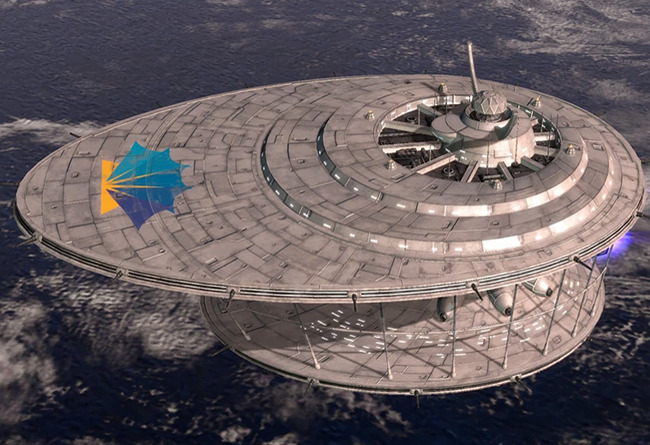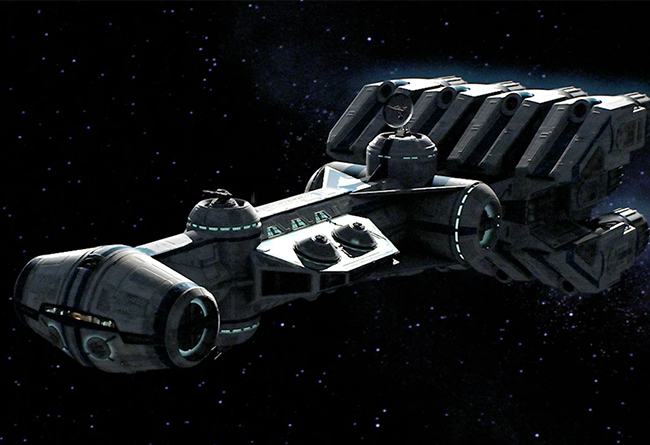Craft: Olanji/Charubah Battle Dragon
Type: Heavy assault warship
Scale: Capitol
Length: 500 Meters in diameter
Skill: Astrogation 5D, capitol ship gunnery 5D+2, capitol ship piloting: Hapan Battle Dragon 6D, capitol ship shields 6D+2, communications 5D+2, sensors 4D+2
Passengers: 500 (troops)
Cargo Capacity: 6,000 metric tons
Consumables: 1 year
Cost: Not available for sale
Hyperdrive Multiplier: X2
Hyperdrive Backup: X14
Nav Computer: Yes
Maneuverability: 1D
Space: 4
Hull: 7D+2
Shields: 3D
Sensors:
Passive: 50/OD
Scan: 100/3D
Search: 200/4D
Focus: 6/4D+2
Weapons:
40 Hapan Turbolaser Batteries
Fire Arc: Rotational
Crew: 3
Skill: Capital ship gunnery
Fire Control: 1D+2
Space Range: 3-15/35/75
Damage: 7D
40 Ion Cannons
Fire Arc: Turret
Crew: 2
Skill: Capital ship gunnery
Fire Control: 3D
Space Range: 1-10/25/50
Atmosphere Range: 2-20/50/100 km
Damage: 3D
4 Pulse Mass Generator Tubes
Fire Arc: 1 front, 1 right, 1 left, 1 back
Crew: 3
Skill: Capital ship gunnery: Pulse Mass Generator
Fire Control: 5D
Space Range: 1-5/75/150
Ammo: 16
Damage: Blocks hyperspace travel; each mine equals a 30-unit diameter
2 Triple Ion Cannons
Fire Arc: Turret
Crew: 2
Skill: Capital ship gunnery
Fire Control: 1D
Space Range: 2-20/50/80
Damage: 3D+2
1 Tractor Beam Projector
Fire Arc: Turret
Crew: 3
Skill: Capital ship gunnery
Fire Control: 4D
Space Range: 1-5/15/30
Damage: 6D
Background: The Hapan Battle Dragons were the premier warships used by the Hapes Consortium. Designed by Olanji/Charubah, Battle Dragons became the primary capital ships of the Hapan Royal Navy, supported by Nova-class battle cruisers. The Hapan fleet, led by Prince Isolder’s crimson Battle Dragon Song of War, contained at least 63 Battle Dragons, each representing one of the Consortium’s worlds.
Battle Dragons featured a unique dual saucer-shaped hull 500 meters in diameter with a central core connected by sixteen rotation support struts. The ships were armed with forty ion cannons and forty turbolaser batteries affixed to rotating circular sections on the top and bottom hull plates. The disc would rotate to bring fresh guns to an enemy to compensate for slowly recharging weaponry. In contrast, the previously used firearms renewed their capacitors, which the Hapans viewed as a more efficient use of firepower.
In addition to the rotating weapon emplacements, Battle Dragons were armed with ten proton torpedo tubes, tractor beam projectors, dorsal- and ventral-mounted heavy triple ion cannon batteries, and sixteen pulsemass mine launchers. Each Battle Dragon carried three squadrons of Miy’til starfighters or T-65 X-wing starfighters in onboard hangars and a battalion of 500 troops. The ships required a crew of 1,200 and 190 gunners.
Battle Dragons were discovered in the battle to have had two serious flaws: firstly, the drive system could be damaged, crippling the vessel. Secondly, the designers intended the Battle Dragon to be used en masse against very few targets. With that end in mind, they skimped on targeting computers, putting in only four.
The effect was to offer outstanding performance against a single target but was useless against a group of targets. Tactics for a lone Battle Dragon against a group were little more than the Dragon choosing a vector and throwing a wall of energy in that direction, hoping that random hits would allow the Dragon to escape, so poor were the few targeting computers’ performance against a mass of targets.
The Hapans used ion cannons to disable the deflector shields of another capital ship, such as an Imperial-class Star Destroyer, and then fired salvos of proton torpedoes. This was highly effective, especially when the Hapans attacked with multiple Battle Dragons, as witnessed during the Battle of Dathomir.
The pulse-mass mines simulated a mass shadow in space to prevent jumps into hyperspace by enemy ships. It was impossible to shut down the mines until their power was depleted, so launching them could be as great a risk to a Battle Dragon as to the ships it was attempting to trap. The three squadrons of Miy’tils were deployed as a fighter screen to prevent heavy bombers from penetrating the ion cannon defense. The ion cannon-based design is unique in capital ship design, but the plan was a realistic response to the Hapes Cluster’s level of advancement – their isolationist stance had resulted in their ion cannon technology being on par with, and perhaps even exceeding, the standard galactic level of achievement, but their turbolaser technology had lagged considerably. After joining the New Republic in their battle against the Yuuzhan Vong, the New Republic updated the Hapan fleet with modern turbolaser technology. Gilad Pellaeon also helped upgrade several Battle Dragons with new Galactic Alliance technology in 40 ABY.





